How To Install Cement Board On Plywood
Building My Store, Part 3 : How To Drywall, Plywood Walls & Fiber Cement Panels
In part 3 of my shop build series, I'll bear witness you how I installed drywall, including taping and mudding, as well as the plywood walls and fiber cement panels in the shop area.
Note: The links below are Amazon chapter links:

Pin information technology!
Procedure For Putting Up Drywall and Plywood Walls:
Let's showtime with the drywall, since that part of this process was the most time consuming. Now, I had never washed any drywall work prior to this, relieve for spackling nail holes, so I deferred to my buddy Justin here.
Pace 1: Hang Sheets Of Drywall On Stud Frames

First, nosotros needed to get the sheets hung on the wall, which was easy enough. We set the trusty line laser to give united states a level reference line, since this floor is and then out of whack, and so we could outset hanging the sheets.
Since the full length of this department of wall was xiv', we cut two feet off of the first sheet. Cutting drywall is extremely simple, yous just score a line through the front end confront of the panel and then snap the panel along the score line. Finally, you cut through the paper backing of the drywall and you're washed.

To hang the panel, we used drywall screws, which is just well-nigh the merely matter I would apply drywall screws for, by the way. We also picked upward this little drywall scroll lifter and used it a ton on this build. It allowed u.s. to raise and lower these panels really precisely before screwing them in identify. I'll have a link to the one we used in the video description below.

On this offset console, we lined upwardly the elevation border of the panel with the laser line, added a few screws to hold it in place, so added the rest of the screws.
Justin had a few of these drywall spiral setters and they worked perfectly with our impact drivers. These $.25 drive the screws to the perfect depth without breaking the newspaper, I would highly recommend picking these upwards if you don't have something like a collated spiral gun.

We added screws every 16" through the center of the panels and then every 8" along the edges.
Also, another tip I picked upwardly from Justin was to concur off on calculation the screws along the border you lot're about to butt some other console up against, as driving the screws tends to mushroom the drywall slightly at the edges and this can create larger gaps between the panels.
Next, nosotros hung the second panel in the row, which was a full length piece in this case. One time once again, nosotros used the lifter to bring the panel in line with the laser and then added screws.
On the second row, we staggered the seams of the panels which helps to minimize future cracks since information technology spreads out the load, only it besides makes taping the seams later on easier.
Other than that, this first wall was basically rinse and echo, since it had no outlets or other things to work around.

With the first wall done, nosotros could move on to the bordering wall. The get-go panel was cut to length and hung, then we could work on the 2nd console.

Justin left this panel total length and so used a drywall saw to cut along the header in the door opening. He could and so score the other side of the console and so cut the rest of the piece abroad with a utility knife.

From there, we only connected working up the wall, filling in pieces where needed. We decided to do the outside and inside walls of the office area in plywood, mostly because drywall is a pain, then we merely needed to practise these two walls.
Once the panels were hung, we could move on to taping and mudding, which was by far the most time consuming function of the process.
Stride 2: Taping and Mudding Drywall Seams

Offset, Justin thinned out this all purpose mud slightly with water, which just made it easier to spread evenly.
The mudding process started on the horizontal seams, since these drywall panels have beveled edges. These edges demand more mud to become level and information technology's besides easier to run the tape for the vertical seams into these horizontal seams subsequently they're already taped.
After applying the starting time layer of mud with a 4" articulation pocketknife, Justin rolled out drywall tape across the seam. One tip here is to apply the tape very lightly, only borer it into place in a few spots, every bit this will let the tape to lay apartment in the next footstep without creasing.

One time the strip of tape was applied, Justin used the same 4" knife to press the record in to place, which likewise removed the excess mud from beneath the tape.

After pressing the tape into identify, Justin would remove any excess mud around the seam with the joint knife.
The process connected in the same way along the length of the seam, applying mud to fill in the askew edge, applying tape, then smoothing the tape and removing the excess mud with the joint knife.
The vertical seams worked in basically the same manner, except we could apply less mud since, again, the ends of the panels aren't askew similar the edges. Likewise, the tape on the vertical seams would overlap the tape on the horizontal seam slightly where those two seams met.

Next, I could try my hand at taping and mudding my offset drywall seam and it went… OK. I was initially applying the mud with likewise much pressure level, which wasn't leaving enough mud on the surface.
Also, when I applied the tape, I pressed it into place besides firmly which didn't let the tape to move with the joint knife when I was smoothing information technology out, which resulted in a crease.
I eventually got it though, and ended up with a pretty decent looking seam.
That said, Justin was still a hell of a lot meliorate at this than I was, so he connected taping and mudding the seams, which saved united states of america a lot of time when information technology came to sanding later, while I focused on filling all of the screw holes.
I also made sure to double check that all of the screws were below the surface of the drywall during this step, as they would be much more difficult to hibernate if they weren't fully seated.
The end of the walls and corners were the last thing to get taped and mudded, equally information technology was easier to run this last seam after all of the horizontal seams were done.
For the inside corner, Justin applied mud to both faces of the corner then creased a length of tape down the center before applying it to the seam. He worked his way down the corner, working each confront and removing any excess mud.

For the corner against the concrete wall, he practical tape flat against the panels and used the excess mud to make full in the gap between the border of the drywall and the concrete.
Afterward taping, Justin applied another layer of mud over the tape and and then we allow it dry overnight.
Step 3: 2d Round Of Drywall Mudding

The next 24-hour interval, we could come back and apply the 2d coat of mud, this time using a wider knife. The goal here is to fan the mud out over the subsequent coats, which feathers the seams, resulting in an invisible seam betwixt the panels.
You can come across that Justin would utilise the mud heavily beyond the seam, then scrape off the excess from the outer edges, leaving the majority of the mud right at the center of the seam. He would then spread that mud out, removing any excess during the process.

In total, Justin practical iv coats of mud over the course of about iv days, working upwards from the original four" knife to a 12" pocketknife for the concluding coat.
Step 3: Sanding Drywall

After the final glaze of mud had stale, we could motility on to everyone's favorite part of drywall work, sanding. This is an incredibly dusty process, and so definitely article of clothing a respirator and plan to go habitation and shower afterwards.
We just used sanding blocks here, since it was a relatively small area, but in that location are all kinds of more complex drywall sanding options if you've got a huge area to exercise.

With the sanding done, the drywall was pretty much finished and just needed to have the dust vacuumed off earlier paint.
Stride 4: Putting Up Plywood Walls In The Shop Space

Next, nosotros could motion on to the plywood walls, which were much easier than the drywall.We really started this process a few weeks ago, prior to installing the insulation, covering ane side of the partition wall.
Start, we made a marker at about 97" off the basis and so prepare the line light amplification by stimulated emission of radiation at that marker. The extra inch of clearance off of the footing would let u.s.a. to keep the plywood lined up while staying clear of the undulating flooring.

On this starting time sheet, we tried a technique that didn't really work well, only I'll tell it to you anyhow. We mounted chip blocks of wood in line with the laser, which we could butt the sheet of plywood up against when hanging information technology.
Now, this would take worked well, just the edges of this plywood weren't dead straight, so it was easier to just line the sheets upwards with the laser by eye.
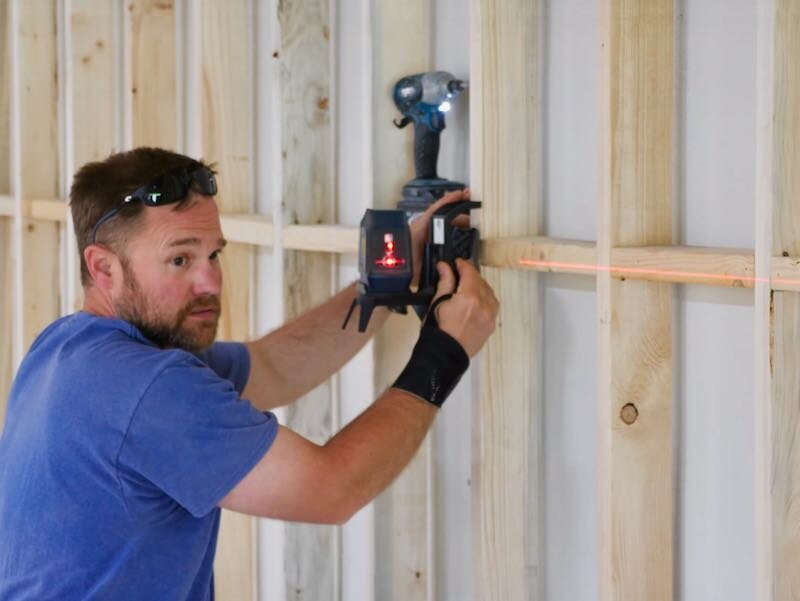
We tacked the start sheet in place with a few screws and and so could work on cutting the second sheet to fit the door opening.
I used my track saw for this, mainly because it has dust collection, but a round saw would accept worked just equally well.

Since the round saw blade doesn't cut all the way to the corner, nosotros finished the cutting with either an aquiver tool or jigsaw, which you'll accept to trust that Justin is doing here.
Once the console was cut, nosotros could get information technology mounted. Y'all can see that this was earlier we picked up that drywall curlicue lifter and we were using a pry bar here instead.
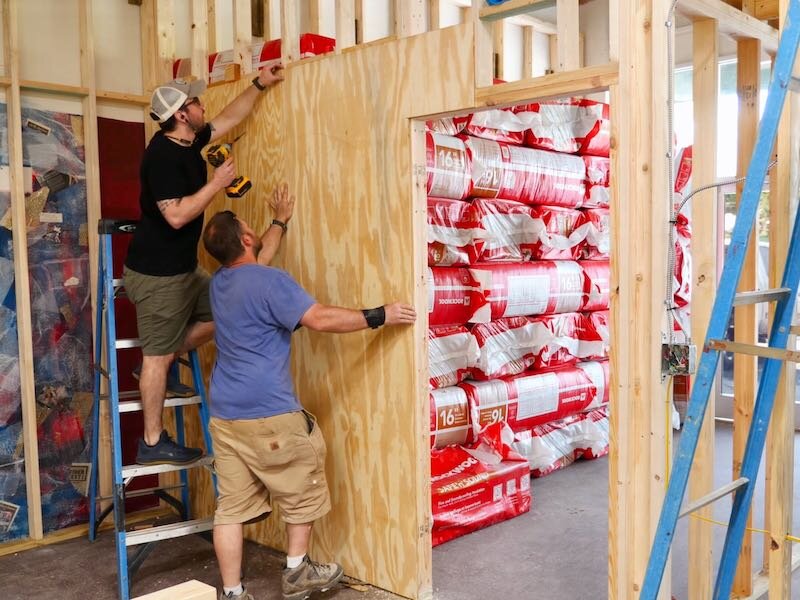
As well, since we knew the offset canvas was plumb and level, we could just reference the top edge of the first sheet and line the 2d sheet up with that edge.
Once nosotros tacked the console in place, I would come dorsum and add the rest of the screws while Justin worked on cutting the next sheet in the row. I added screws roughly every 12" since nosotros used trim head screws here, which have slightly less belongings power than screws with bigger heads but expect much improve in my opinion.
Also, rather than marking out the stud locations, I could utilize the line light amplification by stimulated emission of radiation and add screws along that line. This was much quicker than marking out the locations and your walls won't be left with any marks on them.
We simply connected working downward the row, with Justin cutting the panels and me adding the screws. Also, I realize I didn't get footage of cutting around the electrical box but I'll embrace that a lilliputian later.
With the commencement row washed, we could move upwardly to the second row to finish this side of the partitioning wall. First, we went back and added a piece of blocking to close off the wall section.
Next, we crosscut the panels for the 2nd row, cutting all of them to the aforementioned length to keep them aligned. Again, nosotros used the track saw hither and this actually was the ideal tool for the job and this went really chop-chop.

The panels had to be notched around the outset row of lights, which we did with the jigsaw.

After notching, Justin would hand me the panels and I could install them. Also, I've got to say, this scaffolding was a lifesaver during this whole build out, definitely worth the investment if y'all're going to be taking on a project like this. I have a link to the scaffolding we used hither.
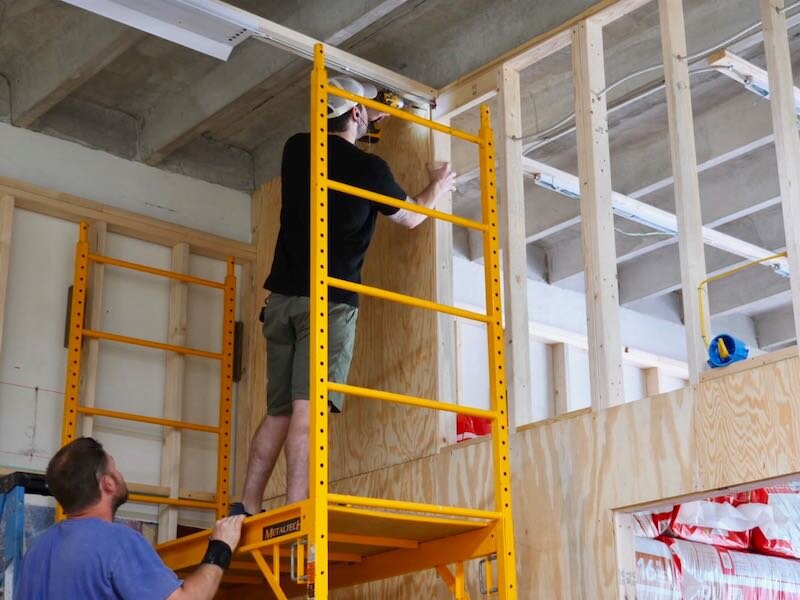
The adjacent panel had a circular electrical box to work around and Justin used a hole saw to cut this opening, although the jigsaw would take as well worked.
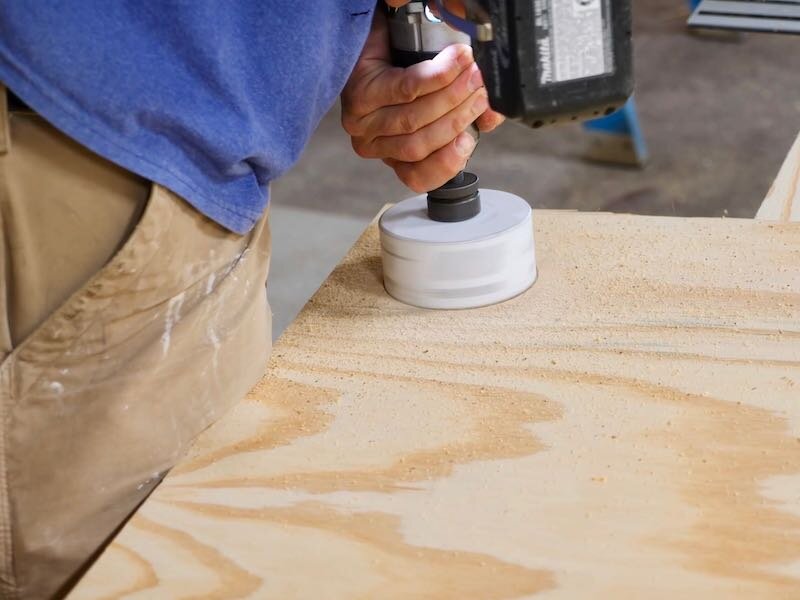
After that, it was actually just rinse and echo to stop off this partition wall, and at present we can fast frontwards to afterwards the insulation was installed.
1 quick tip here: On this wall, I figured out that the light amplification by stimulated emission of radiation was easier to see if I fix it upward a few anxiety off the floor on a ladder, as that made it brighter at the top of the console so the line could be seen even under the bright store lights.

Also, here'due south a close upward of that roll lifter, which even has a bottle opener built in. Again, I'll accept a link to it in the video clarification, information technology was incredibly useful during this whole process.
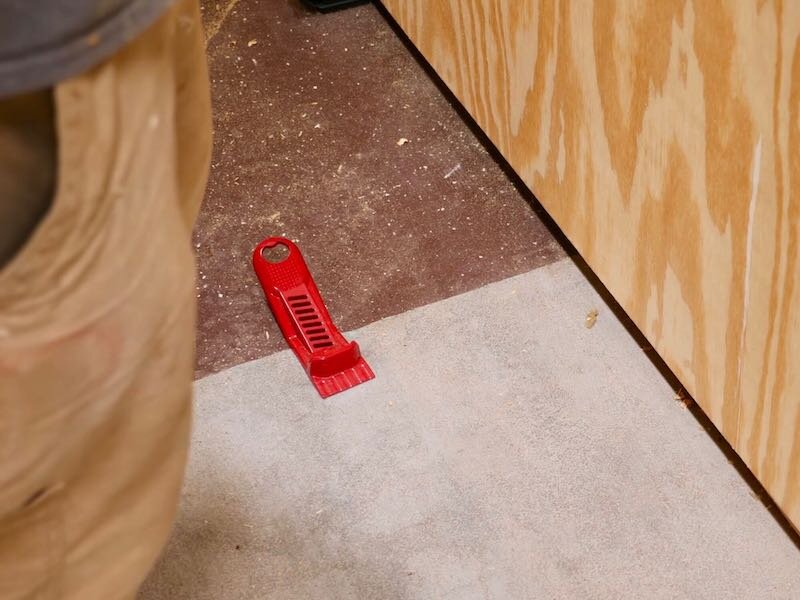
Alright, let'due south have a look at the procedure of cutting effectually the outlet boxes. Justin would take some measurements, referencing off of the previous console, and then would lay them out on the panel using his level and speed square as direct edges.

Since we mounted the electrical boxes using the line laser, we knew they were level and in line with one another, then Justin could extend the horizontal lines for both boxes with the level.
To cut out the openings, he would drill a starter pigsty with a spade fleck and and so cutting out the opening with the jigsaw.
The big trick I picked up here was to undercut the openings past angling the jigsaw, which fabricated lining up the electric box with the cutout much easier while notwithstanding keeping a squeamish tidy reveal around the box.
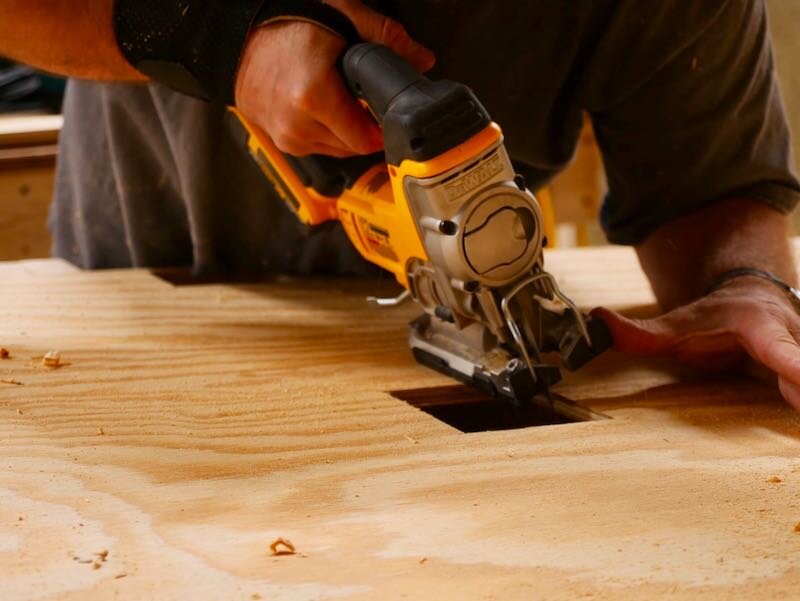
The cutouts lined upward just about perfect and the undercut openings made lining everything up super easy.
Nosotros only kept repeating this process down this wall, stopping at the metalworking section, where we used fiber cement board every bit the wall covering, which we'll become to a piddling later.

To fill in the second row, I could utilize the offcuts from the acme row on the division wall, and I crosscut these to width using my table saw. That said, a circular saw or rail saw would have worked fine here besides.

This summit row went extremely quickly and, with that done, we could move on to the right side of the store.
The process on the second wall was the same, with the only difference being that this wall is 12 anxiety tall vs x feet on the other wall, so nosotros could merely crosscut the sheets of plywood in one-half to fill in the top row.
With that, the plywood in the shop was finished, so we could move on to the plywood walls in the office.
The kickoff boards to get installed were on the ceiling, which nosotros needed to trim about three ½" off the length of, since the office has an interior depth of 8 feet minus the width of the studs.
Side by side, Justin cut out the holes for the can lights, and then we could become the first ceiling console mounted.

Justin whipped up a pair of these deadman supports out of leftover 2x4s and they fabricated installing the ceiling much easier.

Nosotros would lift the panel onto 1 deadman and so elevator the other stop of the panel using the other deadman. These are wedged against the flooring and provide hands costless support of the panel.
With the console supported, I could become dorsum and add screws to concord the ceiling console in identify.
While I ran screws along the studs roughly every 12" on the walls, I used a viii" spacing on the ceiling, as the last matter I desire is this ceiling coming downwardly on summit of me.
We repeated the process for the 2nd ceiling panel and I could continue adding screws while Justin cut the last ceiling console to size.
Once that last panel was mounted on the ceiling, nosotros could motility on to the walls, which went upwardly basically just like the shop walls, with the exception being that we needed to cutting a slight bending on the height of the panels to business relationship for the gradient of the floor.
Yous as well might take noticed that I finally broke down and got a tool pouch during this function of the build, mainly to agree the trim screws. I drove in about 2200 of these trim screws while mounting the plywood, so needless to say I needed to have more screws close at hand during the process.
Also, I got a few questions well-nigh the magnetic screw holder for my impact commuter, which is a gadget from FastCap called the ProHold. I'll have a link to information technology in the video description, it was extremely handy during this build.
With the inside of the office washed, we could move on to the exterior, which was mostly more of the same.
Afterwards adding the first row of panels on the wall, I cut the pieces to size for the in a higher place-the-office storage surface area and got those mounted to the tops of the joists. This area will be nifty for long term storage items.
The last pieces of plywood to attach were the second row on the part walls, which nosotros cut wide enough and then that they covered the ends of the panels on pinnacle of the ceiling.
And let me tell yous, I was pretty excited when it came fourth dimension to get that last piece of plywood installed.
Step 5: Installing Fiber Cement Board Walls In The Metalworking Section Of The Shop

fiber cement panels going upwards in the metalworking area of the shop
With that, the plywood was done, so we could movement on to the last bit of wall covering, which was in the metalworking area of the shop. Nosotros decided to go with these NichiPanel fiber cement panels from 84 Lumber in the metalworking part of the shop, as they'll be more flame resistant than regular plywood.
Ane negative about these types of panels is they can be slightly fragile at the corners, then we did a few tests and found that one of these tile drill bits worked great for drilling holes for our screws.

For the screws, nosotros used these 1 ¼" PowerHead screws from FastCap, which provide a ton of holding power and would again assistance to proceed the panels from breaking off at the corners, unlike a normal bugle head spiral.

Before installing the panels, we would marking out all of the screw locations and drill the holes. We too worked on these panels outside, because cutting or drilling into them is extremely dusty.
To cut around any electric boxes, we used an bending grinder with a diamond cut wheel, which fabricated quick work of the process.

Hanging the panels was only similar the residual of the wall coverings, and having the holes pre-drilled made the process go extremely apace. I also really like the fashion the large heads wait on these panels, I call back this could be a really cool finished expect in a more industrial space.
We simply continued on down the wall, once once more with me driving screws while Justin cut effectually any obstructions. Luckily, nosotros ended up with a full sheet at the end of the wall, which was a happy accident.
For the top row, we did demand to crosscut the panels, and so we swapped out the standard circular saw bract for a blade designed for cutting cobweb cement, which you can encounter has very few teeth compared to a wood cutting blade.

Cut the panels was incredibly messy but went pretty much as quickly as cut the plywood, and then I could pre-drill the holes and get the last row mounted.

With that concluding piece in place, we could call this function of the project complete.
Source: https://craftedworkshop.com/blog/building-my-shop-how-to-drywall-plywood-walls-amp-fiber-cement-panels
Posted by: sykesaloyard41.blogspot.com


0 Response to "How To Install Cement Board On Plywood"
Post a Comment